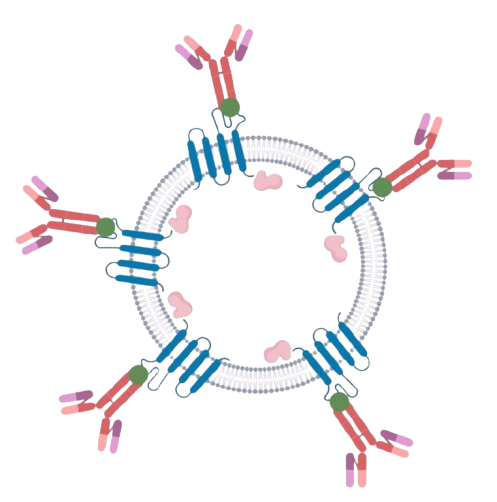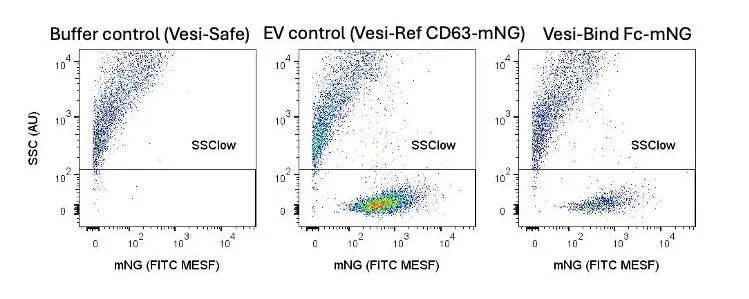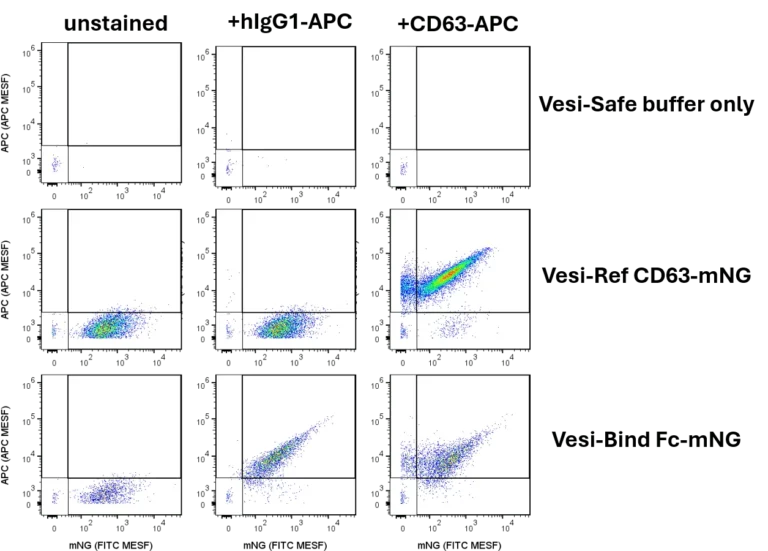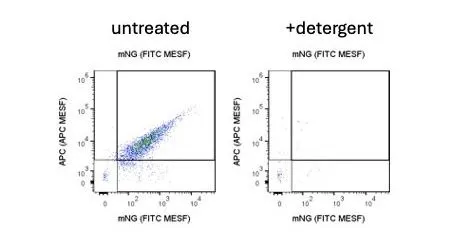
Vesi-Bind Fc-mNG
A new generation of engineered extracellular vesicles for functional studies and analytics
- Home
- Vesi-Bind Fc-mNG engineered extracellular vesicles
Vesi-Bind Fc products offer the unique capability of functionalising EVs with human IgG1, mouse IgG2 or rabbit IgG antibodies at their surface using their Fc domain.
Vesi-Bind Fc-mNG is a new class of biological nanoparticles developed in Samir El Andaloussi’s group at the Karolinska Institute It is an extracellular vesicle isolate from cells engineered to express the fluorescent protein mNeonGreen intraluminally in the presence of the transmembrane tetraspanin protein CD63, as well as a Fc-binding function at their surface

Fast functionalisation of the EV surface with monoclonal antibodies
Vesi-Bind Fc are extracellular vesicles designed to bind the Fc portion of antibodies, allowing the variable regions to be displayed for antigen recognition, can be decorated with various types of antibodies. These Fc-binding EVs can thus be targeted to virtually any tissue (better: antigen) of interest.
Additionally, they display an intraluminal mNeonGreen fluorescent signal, which can be used as a reporter protein domain for uptake & functional assays.

Vesi-Bind Fc-mNG: properties/fluorescence
Analysis by Single EV Imaging Flow Cytometry (Cellstream)

Discover the background research for Vesi-Bind Fc
Vesi-Bind Fc-mNG enables and facilitates the following experiments:
- Fast evaluation of the binding efficiency of antibody-modified EVs to recipient cells
- Modelling for the development of LNP and nanomedicines candidates
- Efficient co-localisation experiments on nanoparticle analysis and super resolution microscopy platforms
- Positive control of (nano)flow cytometry measurements on two fluorescence channels
Flexible EV co-localisation experiments
Co-localisation of unknown EV samples can be difficult to perform given the challenges of the preparation and immunolabeling steps. Vesi-Bind Fc-mNG offers a readily fluorescent source of extracellular vesicles fluorescent on the FITC channel (excitation 488nm, emission 525nm) as well as a second colour via functionalisation with a primary conjugated Fc antibody.
Stable on the bench, as well as in the freezer
Exosomes are known to degrade rapidly once exposed to positive temperatures, hampering short-term projects, as well as analyses. As it is stabilised with Vesi-Safe buffer, Vesi-Bind Fc-mNG can be safely stored for prolonged periods at -80°C to -20°C, as well as at operational temperatures during incubation and analysis, without observable degradation.
Specificity of Antibody binding
Assessment of EV properties/fluorescence and Fc binding functionality
Analysis by Single EV Imaging Flow Cytometry (Cellstream)

Note: This further shows that Vesi-Bind Fc-mNG EVs still have intact CD63 epitopes
Staining Procedure
25 µl buffer or EVs at a concentration of 1e10 particles/mL were stained for 3h at a final conc of 4 nM with antibodies:
- Anti-human-CD63-APC (mouse IgG1), Miltenyi 130-127-492, Lot 5230707982 or
- REA human IgG1 isotype control-APC, Miltenyi 130-113-434, Lot 5190404265
Post staining samples were diluted 1:10000 in PBS-HAT buffer (Görgens et al JEV 2022) before acquisition on an Amnis Cellstream instrument as described before, acquisition time 180 seconds per sample; Data processed and gated as described before (Görgens et al, 2019, Tertel et al, 2020, Dar et al, 2021 [https://doi.org/10.1038/s41467-021-27056-3], Wiklander et al, 2024
A reliable reference material for the standardisation of flow cytometry measurements
(Nano)flow cytometry is now extensively used for extracellular vesicle characterisation including the quantification of particles positive for the presence of specific biomarkers, including tetraspanin (CD9, CD63 and CD81). Assessing the sensitivity of analytical instruments for the detection of particles as small as EVs has always presented a challenge, because of their small optical radius and low density. Being an actual EV isolate, Vesi-Bind Fc-mNG offers the desired optical properties together with fluorescence on two or more channels, allowing the fine-tuning of powerful flow cytometers and sorter for EV work by serving as a new, versatile reference material for studying antibody binding to EVs.
Detergent controls for selected/relevant samples
Analysis by Single EV Imaging Flow Cytometry (Cellstream)
Vesi-Bind Fc-mNG + anti-hIgG1-APC

Vesi-Bind Fc-mNG Technical Description
| Concentration (mNG+/mL, measured by IFCM) |
MFI (FITC MESF) for unstained samples |
Estimate of % engineered (ratio of mNG+APC+ vs APC+) |
Mode diameter NTA (Nanosight) |
Mode diameter NTA (ZetaView) |
Volume | Buffer |
|
3.85 E9 particles/mL |
815.6285 |
88.90% |
128.7nm | 126.1nm | 100µL |
Vesi-Safe |

